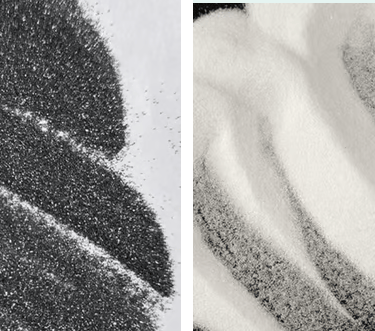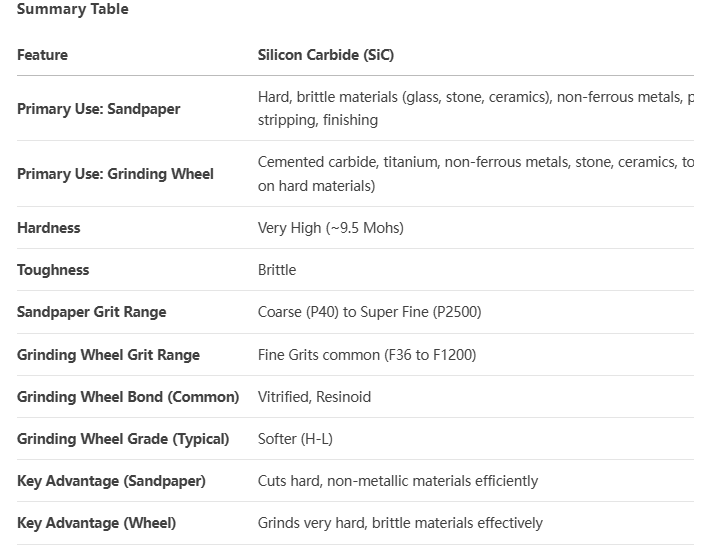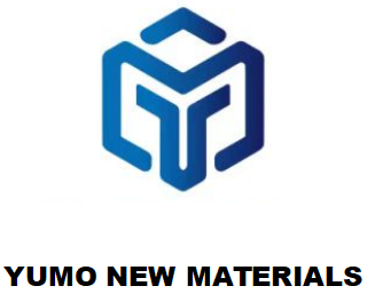HENAN YUMO: Engineered Precision, Uncompromised Performance
Application of Silicon Carbide and White Corundum in Abrasive Tools: Comprehensive Analysis of Sandpaper and Grinding Wheel
Application of Silicon Carbide and White Corundum in Abrasive Tools: Comprehensive Analysis of Sandpaper and Grinding Wheel
6/20/20253 min read


1. Silicon Carbide (SiC)
Composition: Synthetic compound of silicon and carbon.
Hardness: Extremely hard (Mohs ~9.5), but brittle.
Fracture: Sharp, conchoidal fracture creating very sharp cutting edges.
Primary Uses:
Abrasive Paper (Sandpaper): Very common. Ideal for sanding hard, brittle materials (glass, ceramics, stone, marble), non-ferrous metals (aluminum, copper, brass), plastics, rubber, fiberglass, paint stripping, and finishing between coats. Available in sheets, rolls, discs.
Grinding Wheels: Used for specific applications: grinding cemented carbide tools, titanium alloys, non-ferrous metals, stone, ceramics, and for tool room grinding where a fine finish is required on hard materials. Less common for general ferrous metal grinding than Aluminum Oxide.
Common Specifications & Grades (Abrasive Paper):
Grit Size: Ranges from very coarse (e.g., P40, P60) to super fine (P1500, P2000, P2500). Common range: P80 to P1200.
Backing: Paper (various weights), cloth (cotton, polyester, rayon), film (polyester - for ultra-fine grits).
Bond: Resin bond most common. May use glue bond for some flexible papers.
Coatings: Open coat (less abrasive, less clogging) or closed coat (more abrasive, faster cut). Stearated coatings common for sanding finishes to reduce clogging.
Common Names: "Wetordry" (for waterproof papers), "Production Paper".
Common Specifications & Grades (Grinding Wheels):
Grit Size: Typically finer than for Aluminum Oxide wheels, ranging from F36 (coarse) to F1200 (very fine). Common range F46 to F400.
Bond: Vitrified (glass/ceramic - rigid, fast cutting, cool cutting), Resinoid (resin - resilient, shock resistant), Rubber (specialized).
Grade (Hardness): Usually softer grades (H to L) to compensate for brittleness and prevent glazing/burning on hard materials.
Structure: Usually more open structure to aid coolant flow and chip clearance.
Shape: Straight wheels (Type 1), depressed center wheels (Type 27), cylinders, segments.
2. White Aluminum Oxide (White Alumina / WA)
Composition: Purified version of Aluminum Oxide (Al₂O₃), synthesized from calcined alumina. Contains very low levels of impurities like sodium oxide.
Hardness: Very hard (Mohs ~9.0), slightly less hard than SiC but significantly tougher.
Fracture: Friable - breaks down more readily under pressure, continuously exposing new sharp cutting edges ("self-sharpening").
Primary Uses:
Abrasive Paper (Sandpaper): Widely used for woodworking, especially final finishing of bare wood and between coats of paint/varnish/stain. Also excellent for sanding ferrous metals (steel, iron), alloys, and providing fine finishes. Available in sheets, rolls, discs.
Grinding Wheels: The premier choice for precision grinding of hardened steels, high-speed steels, alloy steels, and tool steels. Used for surface grinding, cylindrical grinding, tool and cutter grinding where sharp cutting action, cool cutting, and fine finishes are critical. Also used for snagging and cutoff wheels.
Common Specifications & Grades (Abrasive Paper):
Grit Size: Ranges from coarse (e.g., P40, P60) to ultra-fine (P1500, P2000, P2500). Common range: P80 to P1500.
Backing: Paper (various weights), cloth (cotton, polyester, rayon), film (polyester - for ultra-fine grits).
Bond: Resin bond most common. Glue bond for some flexible papers.
Coatings: Open coat or closed coat. Stearated coatings common for finishing wood finishes.
Common Names: Often labeled as "Premium" or "Finishing" paper.
Common Specifications & Grades (Grinding Wheels):
Grit Size: Wide range, from very coarse (F12, F16) for snagging to very fine (F1000+) for superfinishing. Common precision grinding range: F46 to F800.
Bond: Vitrified (most common for precision grinding), Resinoid (for snagging, cutoff, some tool grinding), Rubber (specialized).
Grade (Hardness): Wide range available (A to Z), selected based on material, operation, and wheel speed. Medium grades (K to P) common for tool steels.
Structure: Varies from dense to open, depending on the application (material removal rate vs. finish).
Shape: Straight wheels (Type 1), depressed center (Type 27), cylinders (Type 2), segments, cup wheels (Type 6, 11), dish wheels (Type 12).
Which is Sandpaper? Which is Grinding Wheel?
Both Silicon Carbide (SiC) and White Aluminum Oxide (WA) are used to make BOTH sandpaper (abrasive paper) and grinding wheels. They are types of abrasive grain, not the finished product type.
Sandpaper/Abrasive Paper: Refers to the flexible coated abrasive product (sheets, rolls, discs).
Grinding Wheel: Refers to the rigid, bonded abrasive product (wheels, stones, segments).
Choosing Between Them:
For Sandpaper:
Choose Silicon Carbide for: Glass, tile, stone, marble, carbon fiber, fiberglass, plastics, rubber, non-ferrous metals, paint stripping.
Choose White Aluminum Oxide for: Bare wood (sanding, finishing), between-coat sanding (paint, varnish, stain), steel, iron, alloys, achieving fine finishes on metals or wood.
For Grinding Wheels:
Choose Silicon Carbide for: Grinding carbide tips/tools, titanium, aluminum, brass, copper, ceramics, stone.
Choose White Aluminum Oxide for: Precision grinding hardened steel, tool steel, high-speed steel, alloy steel, surface/cylindrical grinding requiring fine finish.


